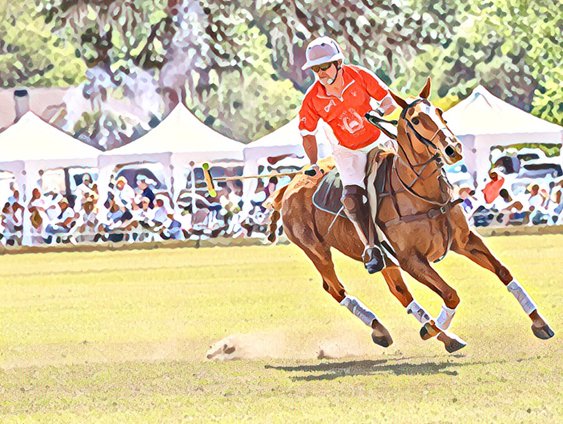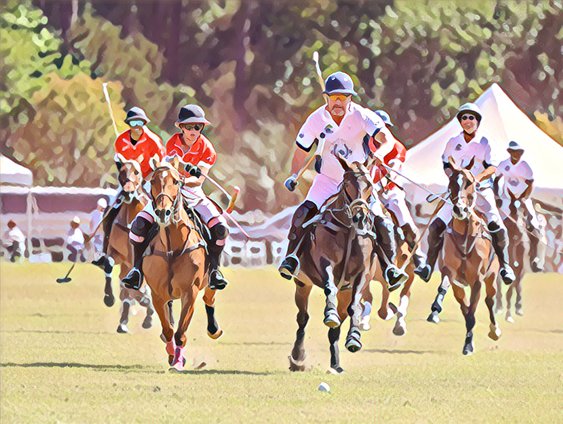Polo Basics



The Game
A traditional polo match lasts about 1½ to 2 hours and is divided into timed periods called chukkers – each chukker is 7 ½ minutes long.
Matches are made up of either four or six chukkers divided by half time.
During halftime, spectators are invited to walk the field to stomp the divots back into the ground that were caused by horse hooves.
A polo team is made up of four players and their ponies.
Players will often change horses (called ponies) after each chukker due to the demands placed on the polo pony during play.
The object of the game is to move the polo ball down the field, hitting the ball through the goal posts to score. The teams change direction after each goal to compensate for field and wind conditions.
Play begins when the umpire throws the ball in at the opening of the first chukker. After each goal is scored, the umpire will resume play with another “bowl in” at the center of the field.
The field is 300 yards long and 160 yards wide - roughly ten football fields.
Most of the rules of polo are for the safety of the polo players and their ponies. The basic concept is that the line of the ball, a right-of-way established by the path of the traveling ball, creates an invisible right of way for the polo player.
Terms Used in Polo
Boards: Short boards along the sidelines of the field to help keep the ball in play.
Bump: When a player directs his pony into the side of an opponent’s pony to move an opposing player off the line of the ball. This must be done at an angle of less than 45.
Chukker: Term used for a period of play in polo. Seven and a half minutes long. There are between four and six chukkers in a match.
Goal: Anytime the ball crosses the line between the goal posts, regardless of who (including ponies) knocks it through.
Hook: Defending an opponent’s swing by blocking it with your own mallet.
Knock in: After the ball crosses the back line, the defending team knocks the ball back into play from their own back line.
Line of the ball: The imaginary line produced by the ball when it is hit or deflected. This creates an invisible right of way that players must adhere to for safety.
Mallet head: The part of the mallet used to strike the ball. The wide face of the head is used to strike the ball.
Nearside: The left hand side of the polo pony.
Offside: The right hand side of the polo pony.
Penalty: A free hit is awarded to the fouled team, from a set distance determined by the severity of the foul committed. Most occur because players improperly cross the line of the ball. All penalties are called to maintain the safety of both the horses and the riders.
Positions: There are four players per team numbered 1 through 4. The most experienced/highest rated usually play positions 2 and 3. #1 is an attacking offensive player, #2 is primarily an offensive player, #3 is a primary play maker, and #4 is a defensive player.
Ride off: Two riders may make contact and attempt to push each other off the line of the ball to prevent an opponent from striking the ball.
Stick: The polo mallet.
Swing: Hitting the ball using one of the four basic shots: forehand, backhand, neck and tail.
Tack: All the equipment used on a polo pony.
Throw in: Play is started by throwing the ball down the center of a line-up of players and horses.